Xuelin Zhang
Step-Audio 2 Technical Report
Jul 24, 2025Abstract:This paper presents Step-Audio 2, an end-to-end multi-modal large language model designed for industry-strength audio understanding and speech conversation. By integrating a latent audio encoder and reasoning-centric reinforcement learning (RL), Step-Audio 2 achieves promising performance in automatic speech recognition (ASR) and audio understanding. To facilitate genuine end-to-end speech conversation, Step-Audio 2 incorporates the generation of discrete audio tokens into language modeling, significantly enhancing its responsiveness to paralinguistic information such as speaking styles and emotions. To effectively leverage the rich textual and acoustic knowledge in real-world data, Step-Audio 2 integrates retrieval-augmented generation (RAG) and is able to call external tools such as web search to mitigate hallucination and audio search to switch timbres. Trained on millions of hours of speech and audio data, Step-Audio 2 delivers intelligence and expressiveness across diverse conversational scenarios. Evaluation results demonstrate that Step-Audio 2 achieves state-of-the-art performance on various audio understanding and conversational benchmarks compared to other open-source and commercial solutions. Please visit https://github.com/stepfun-ai/Step-Audio2 for more information.
Step-Audio-AQAA: a Fully End-to-End Expressive Large Audio Language Model
Jun 10, 2025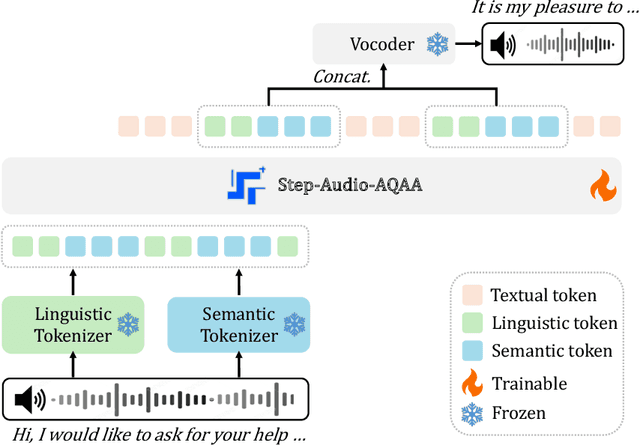
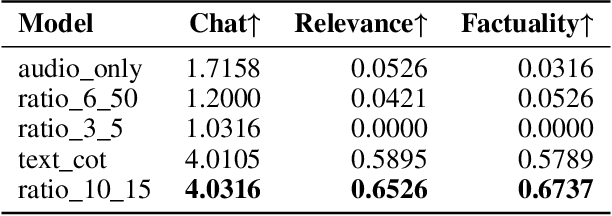
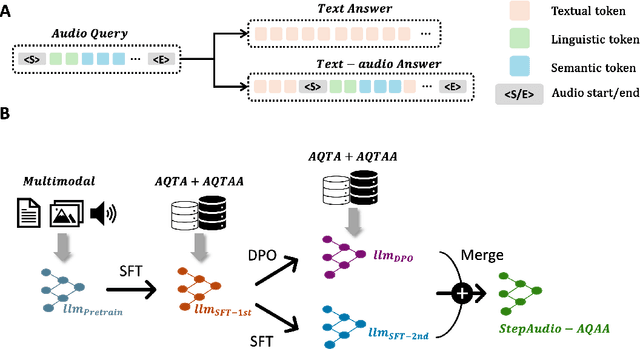

Abstract:Large Audio-Language Models (LALMs) have significantly advanced intelligent human-computer interaction, yet their reliance on text-based outputs limits their ability to generate natural speech responses directly, hindering seamless audio interactions. To address this, we introduce Step-Audio-AQAA, a fully end-to-end LALM designed for Audio Query-Audio Answer (AQAA) tasks. The model integrates a dual-codebook audio tokenizer for linguistic and semantic feature extraction, a 130-billion-parameter backbone LLM and a neural vocoder for high-fidelity speech synthesis. Our post-training approach employs interleaved token-output of text and audio to enhance semantic coherence and combines Direct Preference Optimization (DPO) with model merge to improve performance. Evaluations on the StepEval-Audio-360 benchmark demonstrate that Step-Audio-AQAA excels especially in speech control, outperforming the state-of-art LALMs in key areas. This work contributes a promising solution for end-to-end LALMs and highlights the critical role of token-based vocoder in enhancing overall performance for AQAA tasks.
Step-Audio: Unified Understanding and Generation in Intelligent Speech Interaction
Feb 18, 2025Abstract:Real-time speech interaction, serving as a fundamental interface for human-machine collaboration, holds immense potential. However, current open-source models face limitations such as high costs in voice data collection, weakness in dynamic control, and limited intelligence. To address these challenges, this paper introduces Step-Audio, the first production-ready open-source solution. Key contributions include: 1) a 130B-parameter unified speech-text multi-modal model that achieves unified understanding and generation, with the Step-Audio-Chat version open-sourced; 2) a generative speech data engine that establishes an affordable voice cloning framework and produces the open-sourced lightweight Step-Audio-TTS-3B model through distillation; 3) an instruction-driven fine control system enabling dynamic adjustments across dialects, emotions, singing, and RAP; 4) an enhanced cognitive architecture augmented with tool calling and role-playing abilities to manage complex tasks effectively. Based on our new StepEval-Audio-360 evaluation benchmark, Step-Audio achieves state-of-the-art performance in human evaluations, especially in terms of instruction following. On open-source benchmarks like LLaMA Question, shows 9.3% average performance improvement, demonstrating our commitment to advancing the development of open-source multi-modal language technologies. Our code and models are available at https://github.com/stepfun-ai/Step-Audio.
Generalized Sparse Additive Model with Unknown Link Function
Oct 08, 2024



Abstract:Generalized additive models (GAM) have been successfully applied to high dimensional data analysis. However, most existing methods cannot simultaneously estimate the link function, the component functions and the variable interaction. To alleviate this problem, we propose a new sparse additive model, named generalized sparse additive model with unknown link function (GSAMUL), in which the component functions are estimated by B-spline basis and the unknown link function is estimated by a multi-layer perceptron (MLP) network. Furthermore, $\ell_{2,1}$-norm regularizer is used for variable selection. The proposed GSAMUL can realize both variable selection and hidden interaction. We integrate this estimation into a bilevel optimization problem, where the data is split into training set and validation set. In theory, we provide the guarantees about the convergence of the approximate procedure. In applications, experimental evaluations on both synthetic and real world data sets consistently validate the effectiveness of the proposed approach.
Waveguide Superlattices with Artificial Gauge Field Towards Colorless and Crosstalkless Ultrahigh-Density Photonic Integration
Jul 10, 2024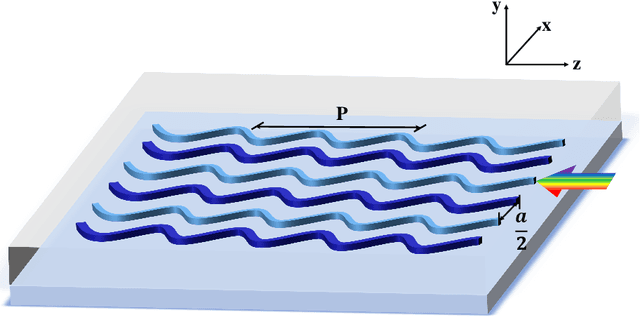
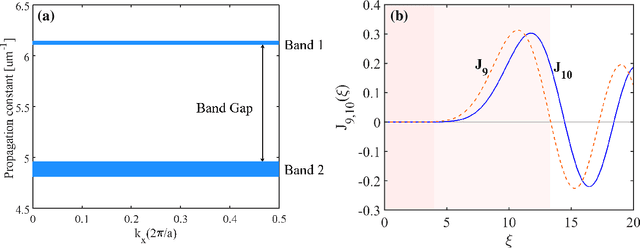
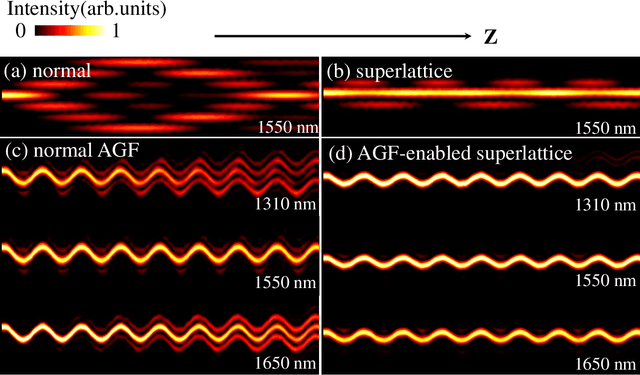
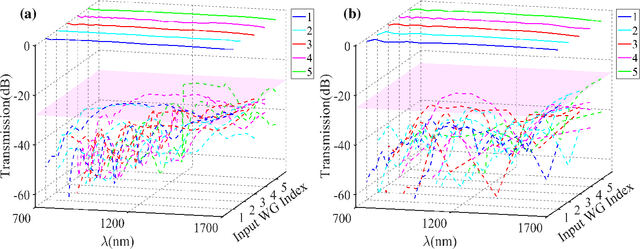
Abstract:Dense waveguide arrays with low crosstalk and ultra-broadband remain a vital issue for chip-scale integrated photonics. However, the sub-wavelength regime of such devices has not been adequately explored in practice. Herein, we propose the advanced waveguide superlattices leveraging the artificial gauge field mechanism. This approach achieves remarkable -24 dB crosstalk suppression with an ultra-broadband bandwidth, experimentally demonstrated over 500 nm, in silicon nitride waveguides. Moreover, the 112 Gbit/s signal encoded per channel of ultra-compact circuits with a bit error rate below the 7% forward error correction limit verified the capability for high-speed on-chip transmission. This design is compatible with metal back end-of-the-line (BEOL) processes and can be readily transferred to other platforms. Thus it holds great promise for significant reduction in on-chip footprint and cost in large-scale integrated photonics, and salient enhancement in the performance of a wide range of active and passive photonic devices and systems.
Towards Trustable Skin Cancer Diagnosis via Rewriting Model's Decision
Mar 02, 2023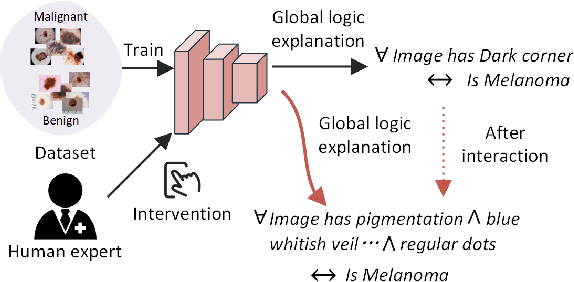

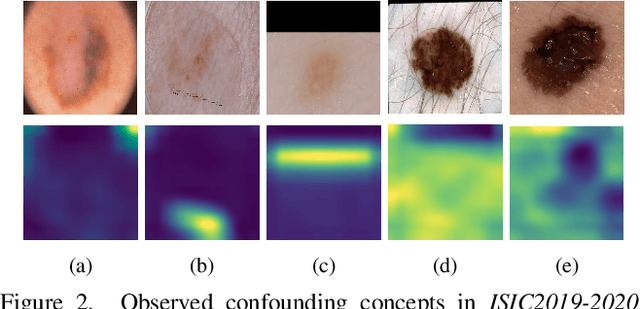

Abstract:Deep neural networks have demonstrated promising performance on image recognition tasks. However, they may heavily rely on confounding factors, using irrelevant artifacts or bias within the dataset as the cue to improve performance. When a model performs decision-making based on these spurious correlations, it can become untrustable and lead to catastrophic outcomes when deployed in the real-world scene. In this paper, we explore and try to solve this problem in the context of skin cancer diagnosis. We introduce a human-in-the-loop framework in the model training process such that users can observe and correct the model's decision logic when confounding behaviors happen. Specifically, our method can automatically discover confounding factors by analyzing the co-occurrence behavior of the samples. It is capable of learning confounding concepts using easily obtained concept exemplars. By mapping the black-box model's feature representation onto an explainable concept space, human users can interpret the concept and intervene via first order-logic instruction. We systematically evaluate our method on our newly crafted, well-controlled skin lesion dataset and several public skin lesion datasets. Experiments show that our method can effectively detect and remove confounding factors from datasets without any prior knowledge about the category distribution and does not require fully annotated concept labels. We also show that our method enables the model to focus on clinical-related concepts, improving the model's performance and trustworthiness during model inference.
 Add to Chrome
Add to Chrome Add to Firefox
Add to Firefox Add to Edge
Add to Edge